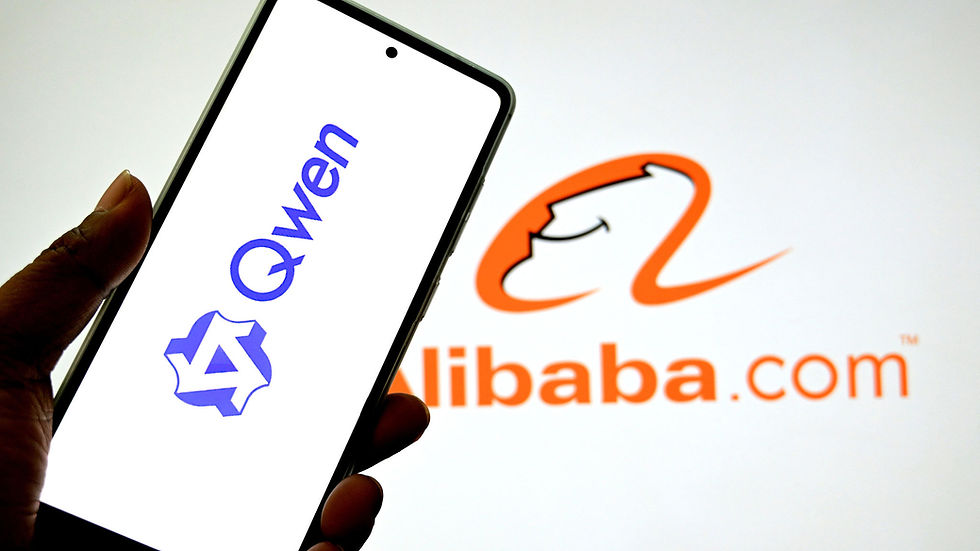Alibaba Launches Cost-Efficient AI Model, Qwen3-Next-80B-A3B
- tech360.tv

- Sep 15
- 3 min read
Alibaba Cloud, the artificial intelligence and cloud computing division of Alibaba Group Holding, unveiled a new generation of large language models on Friday. These models significantly reduce costs and size while matching the strong performance of larger predecessors.

The new Qwen3-Next-80B-A3B model is nearly 13 times smaller than Alibaba’s largest artificial intelligence model, released a week earlier. Developers report it performs 10 times faster in some tasks than the Qwen3-32B model, released in April, with a 90% reduction in training costs.

This efficiency positions Qwen3-Next-80B-A3B as one of Alibaba’s best models to date. Emad Mostaque, co-founder of the UK-based start-up Stability AI, stated on X that the model outperformed "pretty much any model from last year."
Mostaque estimated the model's training cost at less than USD 500,000. For comparison, Google’s Gemini Ultra, released in February 2024, cost an estimated USD 191 million to train, according to Stanford University’s AI Index.
Artificial Analysis, a leading artificial intelligence benchmarking firm, reported Qwen3-Next-80B-A3B surpassed the latest versions of DeepSeek R1 and Alibaba-backed start-up Moonshot AI’s Kimi-K2. The new model also costs less to run on Alibaba’s cloud platform than the Qwen3-235B-2507, which contains 235 billion parameters.
Artificial intelligence researchers attributed the model’s success to "hybrid attention," a relatively new technique addressing diminishing efficiency returns in existing models. Qwen3-Next-80B-A3B incorporates "Gated DeltaNet," proposed by Massachusetts Institute of Technology and Nvidia researchers in March.
Zhou Peilin, an artificial intelligence researcher at the Hong Kong University of Science and Technology, noted Gated DeltaNet enhances attention by making targeted adjustments to input data, leading to an accurate yet cost-effective mechanism. Juergen Schmidhuber, a computer science professor at the King Abdullah University of Science and Technology and a contributor to DeltaNets development in the 1990s, said it was “great to see that our DeltaNets … have been greatly scaled up by Alibaba to build excellent AI models.”
The model also uses a "mixture-of-experts" (MoE) architecture, which has improved efficiency in Chinese artificial intelligence models, including DeepSeek-V3 and Moonshot’s Kimi-K2. Alibaba enhanced the "sparsity" of its MoE architecture for further gains.
Qwen3-Next-80B-A3B features 512 experts but activates only 10 at a time, showcasing enhanced sparsity. Artificial Analysis confirmed these innovations helped the model achieve parity with DeepSeek-V3.1, despite Qwen3-Next-80B-A3B having just 3 billion active parameters versus 37 billion.
This new architecture reflects a growing industry interest in smaller, more efficient artificial intelligence models, amid rising concerns about scaling costs. According to AI research firm Epoch AI, xAI’s Grok 4 had the most expensive training run to date at USD 490 million, with future runs projected to exceed USD 1 billion by 2027.
In August, Nvidia researchers published a paper advocating for small language models as the future of agentic AI due to their flexibility and efficiency. Nvidia is also experimenting with Gated DeltaNet on its Nemotron models. Chinese artificial intelligence giants are also promoting models compact enough for laptops and smartphones.
Tencent Holdings launched four open-source artificial intelligence models last month, each under 7 billion parameters, while Beijing-based start-up Z.ai released the GLM 4.5 Air model with just 12 billion active parameters. Artificial Analysis noted Qwen3-Next-80B-A3B is compact enough for a single Nvidia H200 graphics processing unit.
The model quickly broke into the Hugging Face trending leaderboard, amassing nearly 20,000 downloads within 24 hours of launch. Alibaba stated its new architecture previews its next generation of artificial intelligence models.
Tobias Schröder, an artificial intelligence researcher at Imperial College London, suggested the future of large language models would likely revolve around refining Alibaba’s approach to address training costs and efficiency, even if entirely different architectures emerge.
Alibaba Cloud unveiled Qwen3-Next-80B-A3B, a new generation of large language models designed for efficiency.
The model is nearly 13 times smaller and 90% cheaper to train, performing 10 times faster than preceding models.
Key technical innovations include "hybrid attention," "Gated DeltaNet," and an enhanced "mixture-of-experts" (MoE) architecture.
Source: SCMP


